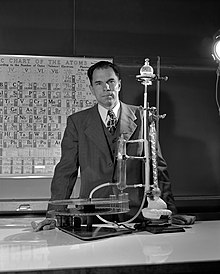
Back تاريخ الجدول الدوري Arabic পর্যায় সারণির ইতিহাস Bengali/Bangla Història de la taula periòdica Catalan Det periodiske systems historie Danish تاریخ جدول تناوبی Persian आवर्त सारणी का इतिहास Hindi Sejarah tabel periodik ID ആവർത്തനപ്പട്ടികയുടെ ചരിത്രം Malayalam Geschiedenis van het periodiek systeem Dutch História da tabela periódica Portuguese

| Part of a series on the |
| Periodic table |
|---|
The periodic table is an arrangement of the chemical elements, structured by their atomic number, electron configuration and recurring chemical properties. In the basic form, elements are presented in order of increasing atomic number, in the reading sequence. Then, rows and columns are created by starting new rows and inserting blank cells, so that rows (periods) and columns (groups) show elements with recurring properties (called periodicity). For example, all elements in group (column) 18 are noble gases that are largely—though not completely—unreactive.
The history of the periodic table reflects over two centuries of growth in the understanding of the chemical and physical properties of the elements, with major contributions made by Antoine-Laurent de Lavoisier, Johann Wolfgang Döbereiner, John Newlands, Julius Lothar Meyer, Dmitri Mendeleev, Glenn T. Seaborg, and others.[1][2]
- ^ IUPAC article on periodic table Archived 2008-02-13 at the Wayback Machine
- ^ Cite error: The named reference
NYT-20190827was invoked but never defined (see the help page).